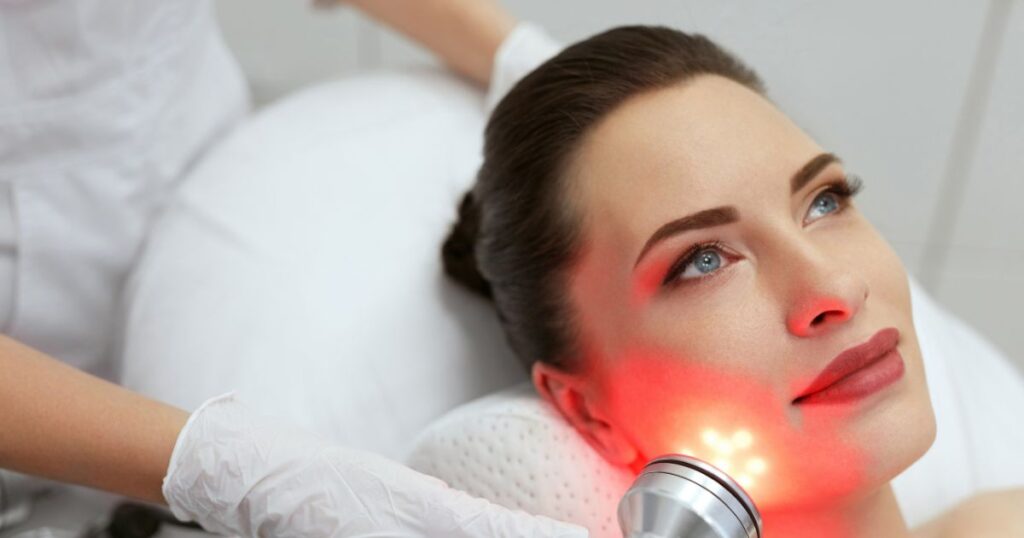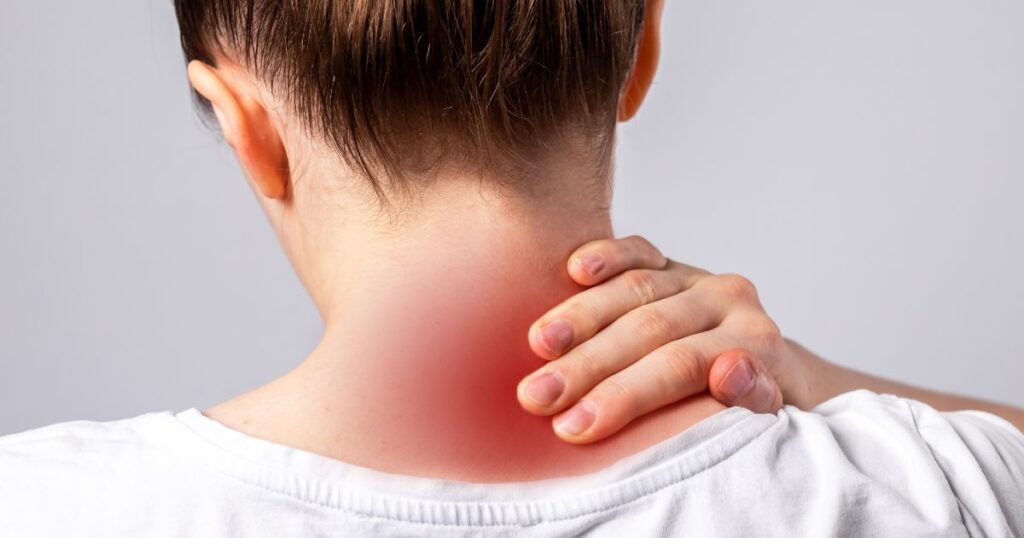The quest for non-invasive and natural health treatments has brought Red Light Therapy (RLT) into the spotlight. As we increasingly seek alternatives to traditional medical interventions, RLT stands out for its simplicity and efficacy. This guide aims to demystify RLT, shedding light on:
- Its Growing Popularity: Understanding why RLT is becoming a favored choice in skincare and pain management.
- Benefits and Mechanisms: Exploring how RLT works and the various benefits it offers.
- Practical Insights: Providing a comprehensive overview of RLT’s applications and considerations.
Join us as we delve into the world of Red Light Therapy, uncovering its potential to revolutionize our approach to wellness and self-care.
Table of Contents - Click to Go
What Is Red Light Therapy?
Red Light Therapy (RLT), also known as Low-Level Laser Therapy (LLLT), is a non-invasive treatment that has gained popularity for its wide range of health and wellness benefits. But what exactly is it, and how does it work? Here’s a deep dive into the essence of RLT:
- Definition: RLT is a therapeutic technique that uses low-wavelength red light to treat skin issues, such as wrinkles, scars, and persistent wounds, as well as other conditions like pain and inflammation.
- How It Works: At the cellular level, RLT works by delivering specific wavelengths of red light into the skin’s deeper layers. This light is absorbed by mitochondria, the powerhouse of cells, enhancing their function and promoting healing and rejuvenation.
- A Brief History:
- Origins: The concept of light as a therapeutic tool dates back to ancient times, but the modern use of RLT began with NASA experiments in the late 20th century, exploring the growth of plants in space.
- Evolution: These studies uncovered the potential for red light to accelerate healing and tissue regeneration in humans. Since then, RLT has evolved into a widely accepted treatment method across various medical and cosmetic fields.
In a nutshell, Red Light Therapy is a testament to the power of light in healing and revitalization. Its journey from space experiments to a mainstay in therapeutic treatments underscores its effectiveness and growing acceptance in promoting health and wellness.
How Red Light Therapy Works

The effectiveness of Red Light Therapy (RLT) isn’t just anecdotal; it’s grounded in scientific research and biological mechanisms. Let’s explore the science that makes RLT a compelling treatment option:
- Mitochondrial Activation: The core of RLT’s effectiveness lies in its ability to stimulate mitochondria, the cell’s energy producers. This stimulation leads to:
- Increased production of adenosine triphosphate (ATP), the energy currency of the cell.
- Enhanced cellular metabolism and regeneration.
- Photobiomodulation: This is the process through which light energy causes changes in cell behavior. RLT:
- Promotes wound healing by increasing collagen production, crucial for skin elasticity and strength.
- Reduces inflammation, a key factor in many chronic conditions and pain.
- Key Research Findings:
- Studies have shown that RLT can significantly improve skin complexion and increase collagen, essential for skin’s firmness and elasticity.
- Research on pain management indicates that RLT can reduce inflammation and pain in conditions like arthritis, providing a non-pharmacological pain relief option.
- Mechanisms at Work:
- Anti-inflammatory Effects: By decreasing the production of inflammatory cytokines, RLT helps in reducing swelling and pain.
- Enhanced Circulation: It promotes blood flow to the treated areas, facilitating the removal of waste products and the supply of nutrients.
In Summary, the science behind Red Light Therapy is robust, explaining its effectiveness across a range of applications. By influencing cellular processes directly, RLT offers a promising avenue for enhancing health and wellness without the need for invasive procedures.
Benefits of Red Light Therapy

Red Light Therapy (RLT) offers a multitude of benefits that span from enhancing skin health to aiding in pain management and accelerating the healing process. Below, we delve into the major benefits of RLT, backed by scientific evidence:
For Skin Health
- Improved Complexion and Texture: Regular RLT sessions can lead to a smoother, more even skin tone by reducing the appearance of fine lines, wrinkles, and pores.
- Increased Collagen Production: Collagen is vital for maintaining skin elasticity and firmness. RLT stimulates collagen production, combating signs of aging.
- Reduction in Acne and Inflammation: By controlling inflammation and reducing bacteria, RLT can alleviate acne and improve overall skin health.
Accelerated Wound Healing
- Enhances Cellular Repair: RLT speeds up the natural healing process by stimulating the cells responsible for tissue repair and regeneration.
- Reduces Scarring: By improving healing and reducing inflammation, RLT can minimize the formation of scar tissue.
Pain Reduction
- Inflammation Reduction: RLT is effective in reducing inflammation, a common cause of pain in conditions like arthritis and back pain.
- Chronic Pain Management: Studies have shown that RLT can help manage chronic pain, offering a non-invasive alternative to medication.
Other Benefits
- Improved Sleep Quality: Exposure to red light has been linked to improved sleep quality, possibly by regulating melatonin levels.
- Enhanced Physical Performance: By reducing inflammation and promoting muscle recovery, RLT can enhance physical performance and reduce exercise-induced muscle fatigue.
In Conclusion, the benefits of Red Light Therapy are extensive and supported by growing scientific evidence. Whether you’re looking to improve your skin, accelerate healing, manage pain, or simply boost your overall wellness, RLT presents a promising, non-invasive treatment option.
For Skin Conditions
Red Light Therapy (RLT) has shown remarkable results in treating various skin conditions, making it a popular choice for those seeking clearer, healthier skin without the use of harsh chemicals or invasive procedures.
Here’s a table summarizing how Red Light Therapy (RLT) can benefit different skin conditions, the positive effects it has, and a brief explanation for each:
| Skin Condition | Positive Effect of RLT | Explanation |
| Acne | Reduces inflammation and controls bacteria | RLT targets inflammation and bacteria deep within the skin, reducing the severity of acne. |
| Wrinkles and Fine Lines | Stimulates collagen production and improves skin elasticity | By increasing collagen and elastin, RLT helps smooth out wrinkles and improve skin firmness. |
| Rosacea | Reduces redness and soothes skin | Regular RLT sessions can lessen the chronic redness and discomfort associated with rosacea. |
| Scars and Stretch Marks | Promotes healing and improves skin texture | RLT accelerates the skin’s healing processes, making scars and stretch marks less visible. |
| Eczema and Psoriasis | Alleviates symptoms | Though not a cure, RLT can reduce itchiness and improve the appearance of eczema and psoriasis. |
This table highlights the versatility of RLT in treating a range of skin conditions by leveraging its anti-inflammatory, healing, and collagen-boosting properties.
For Pain Management
Red Light Therapy (RLT) has emerged as a promising non-invasive treatment for various forms of pain, including chronic conditions and acute discomfort. Here’s how RLT can be beneficial for pain management:
- Reducing Inflammation: One of the key mechanisms by which RLT helps manage pain is through its ability to reduce inflammation. Inflammation is often a significant contributor to pain, particularly in conditions like arthritis and back pain.
- Enhancing Circulation: Improved blood flow to affected areas can accelerate healing and reduce pain symptoms. RLT stimulates circulation, aiding in the removal of waste products and the delivery of oxygen and nutrients to tissue.
- Stimulating Healing: By promoting cellular repair and regeneration, RLT can help heal the underlying causes of pain, rather than just masking symptoms. This is particularly beneficial for injuries and conditions affecting muscles and joints.
- Decreasing Muscle Tension: RLT has been shown to reduce muscle spasms and stiffness, providing relief from discomfort and improving mobility.
Conditions Benefited by RLT:
Below is a table that outlines the conditions (arthritis, back pain, neuropathy), the benefits of using Red Light Therapy (RLT) for each, and a brief explanation of how RLT aids in managing these conditions.
| Condition | Benefits of RLT | Explanation |
| Arthritis | Pain Reduction | RLT helps reduce joint inflammation and pain, enhancing mobility and quality of life for individuals with arthritis by improving mitochondrial function and reducing inflammatory markers. |
| Back Pain | Decreased Discomfort | By targeting deep tissue, RLT can alleviate chronic back pain by reducing inflammation and stimulating cellular repair, leading to pain relief and improved function. |
| Neuropathy | Improved Nerve Function | RLT supports nerve healing and reduces symptoms of neuropathy, such as numbness and tingling, by enhancing blood circulation and reducing inflammation in affected areas. |
Using RLT for Pain Management:

- Consultation: Begin with a consultation with a healthcare provider to ensure RLT is appropriate for your condition.
- Targeted Treatment: Use RLT devices specifically on areas affected by pain, following device guidelines for distance and duration.
- Integration: Incorporate RLT into a broader pain management plan, which may include physical therapy, medication, and other treatments.
In Summary, Red Light Therapy offers a versatile, effective approach to managing pain without the need for invasive procedures or reliance on pharmaceuticals. Its ability to reduce inflammation, enhance circulation, and promote healing makes it a valuable tool in the treatment of a wide range of painful conditions.
How to Use Red Light Therapy
Utilizing Red Light Therapy (RLT) effectively at home involves understanding the right approach to maximize its benefits while ensuring safety. Here’s a guide on how to use RLT devices:
Choosing the Right Device
- Research: Look for devices with clinical evidence supporting their efficacy.
- Specifications: Ensure the device emits light in the red to near-infrared spectrum (630nm to 850nm), which is most effective for therapeutic purposes.
Preparation for Use
- Clean Skin: Start with clean, dry skin for maximum light penetration.
- Safety Gear: Use protective eyewear if recommended by the device manufacturer.
Using the Device
- Distance: Position the device according to the manufacturer’s instructions, usually a few inches away from the skin.
- Duration: Treatment times can vary, but typically range from 5 to 20 minutes per session.
- Frequency: Most guidelines suggest daily sessions, though some conditions may require less frequent use.
Post-Treatment
- Skincare: Apply moisturizer if your skin feels dry, but avoid using products that could block light absorption right before sessions.
- Hydration: Stay hydrated to support your skin’s natural healing processes.
Consistency and Patience
- Regular Sessions: Consistency is key. Regular, continued use is necessary to see results.
- Patience: Improvements may take several weeks to become noticeable.
Safety and Considerations
- Avoid Overuse: Follow the recommended duration and frequency to prevent skin irritation.
- Monitor Skin Reaction: Pay attention to how your skin responds and adjust usage if necessary.
In Summary, successfully incorporating Red Light Therapy into your wellness routine requires selecting the right device, preparing properly for treatments, and adhering to a consistent treatment schedule. While RLT is generally safe, always use the device as directed and consult with a healthcare provider if you have any concerns.
Potential Side Effects and Considerations

While Red Light Therapy (RLT) is celebrated for its broad spectrum of benefits and minimal risk profile, it’s important to approach any treatment with an understanding of potential side effects and considerations. Here’s what you need to know:
Potential Side Effects
Here’s a table outlining the potential side effects of Red Light Therapy (RLT), their symptoms, and an explanation for each:
| Potential Side Effects | Symptoms | Explanation |
| Skin Irritation | Redness, itching | Temporary irritation or redness can occur, especially in individuals with sensitive skin or when exposed to the light for extended periods. |
| Eye Strain | Discomfort, headache | Direct exposure to the bright light of RLT devices without proper eye protection can cause discomfort or strain to the eyes. |
| Overuse | Diminished results, skin discomfort | Using RLT more frequently than recommended can lead to less effective outcomes and may cause skin discomfort or damage. |
Important Considerations
Here’s a table that organizes the important considerations into categories, detailing what to avoid and providing explanations for each:
| Important Considerations | What to Avoid | Explanation |
| Skin Conditions | Unconsulted Use of RLT | Individuals with certain skin conditions should seek medical advice before using RLT, as it may exacerbate or negatively affect their condition. |
| Photosensitivity | Use without medical advice | Those who are photosensitive or on photosensitizing medications should avoid RLT without consulting a healthcare provider due to the risk of adverse reactions. |
| Pregnancy | Use without consulting a doctor | Pregnant women should consult with a healthcare provider before using RLT, as the effects on pregnancy are not fully researched. |
| Medical Conditions | Use without professional guidance | Individuals with serious medical conditions, especially cancer, should consult a healthcare professional to ensure RLT is safe for their specific health situation. |
Maximizing Safety
- Follow Guidelines: Adhere to the manufacturer’s instructions regarding duration and frequency of use.
- Protective Measures: Use protective eyewear if recommended and avoid looking directly into the light sources.
- Start Slowly: Begin with shorter sessions and gradually increase as your tolerance builds, paying attention to how your body responds.
In Summary, RLT is generally safe with a low risk of side effects. However, individual responses can vary, and it’s important to consider personal health conditions and follow recommended safety practices. Consulting with a healthcare provider before starting RLT can help ensure the treatment is appropriate and beneficial for you.
Conclusion

Red Light Therapy (RLT) stands out as an effective, non-invasive option for improving skin health, alleviating pain, and enhancing overall wellness. By stimulating cellular activity and increasing ATP production, it offers a science-backed approach to treating various conditions with minimal side effects. While RLT is distinct in its ease and safety of use compared to traditional therapies, it’s important to use it correctly and consult healthcare professionals for personalized guidance. RLT exemplifies a modern, gentle approach to health and wellness, suitable for those exploring alternative treatments.
Key Takeaways
Here are the essential points to remember from our comprehensive guide on Red Light Therapy:
- Understanding RLT: Red Light Therapy is a non-invasive treatment using low-wavelength red light, beneficial for skin health, pain relief, and overall wellness.
- Scientific Basis: The effectiveness of RLT lies in its ability to stimulate mitochondria in cells, enhancing energy production and promoting healing and rejuvenation.
- Diverse Benefits: RLT offers multiple health benefits, including improving skin conditions like acne and wrinkles, accelerating wound healing, and aiding in pain management.
- Comparison with Other Treatments: RLT is a gentler alternative to traditional treatments, with minimal side effects, making it a preferred choice for many.
- Usage Guidelines: Proper use of RLT involves choosing the right device, adhering to recommended treatment durations and frequencies, and ensuring safety measures like eye protection.
- Safety and Side Effects: While RLT is generally safe, potential side effects like skin irritation or eye strain can occur, and it’s essential to consult healthcare providers for specific health conditions.
This summary encapsulates the key aspects of Red Light Therapy, highlighting its significance as a modern therapeutic tool in health and wellness.
FAQs About Red Light Therapy
1. What exactly is Red Light Therapy?
- Red Light Therapy (RLT) is a treatment that uses specific wavelengths of red light to improve skin health, reduce pain, and enhance overall wellness.
2. How does Red Light Therapy work?
- RLT works by stimulating the mitochondria in cells, enhancing energy production and promoting healing and rejuvenation at a cellular level.
3. Is Red Light Therapy safe to use?
- Yes, RLT is generally safe with minimal side effects. However, individuals with certain health conditions or sensitivities should consult a healthcare provider first.
4. What are the main benefits of using Red Light Therapy?
- Benefits include improved skin conditions like acne and wrinkles, accelerated wound healing, pain reduction, and enhanced overall well-being.
5. Can Red Light Therapy help with chronic pain?
- Yes, RLT has been shown to reduce inflammation and alleviate pain in conditions like arthritis and back pain.
6. How long does it take to see results from Red Light Therapy?
- Results vary, but many users start to see improvements within a few weeks of consistent use.
7. Is Red Light Therapy effective for acne?
- RLT can be effective in reducing inflammation and improving skin health, which can help in managing acne.
8. Can Red Light Therapy replace my current skincare routine?
- While RLT can enhance skin health, it should be used as a complement to a regular skincare routine, not a replacement.
9. How often should I use Red Light Therapy?
- The frequency can vary depending on the device and the condition being treated, but daily sessions are common.

